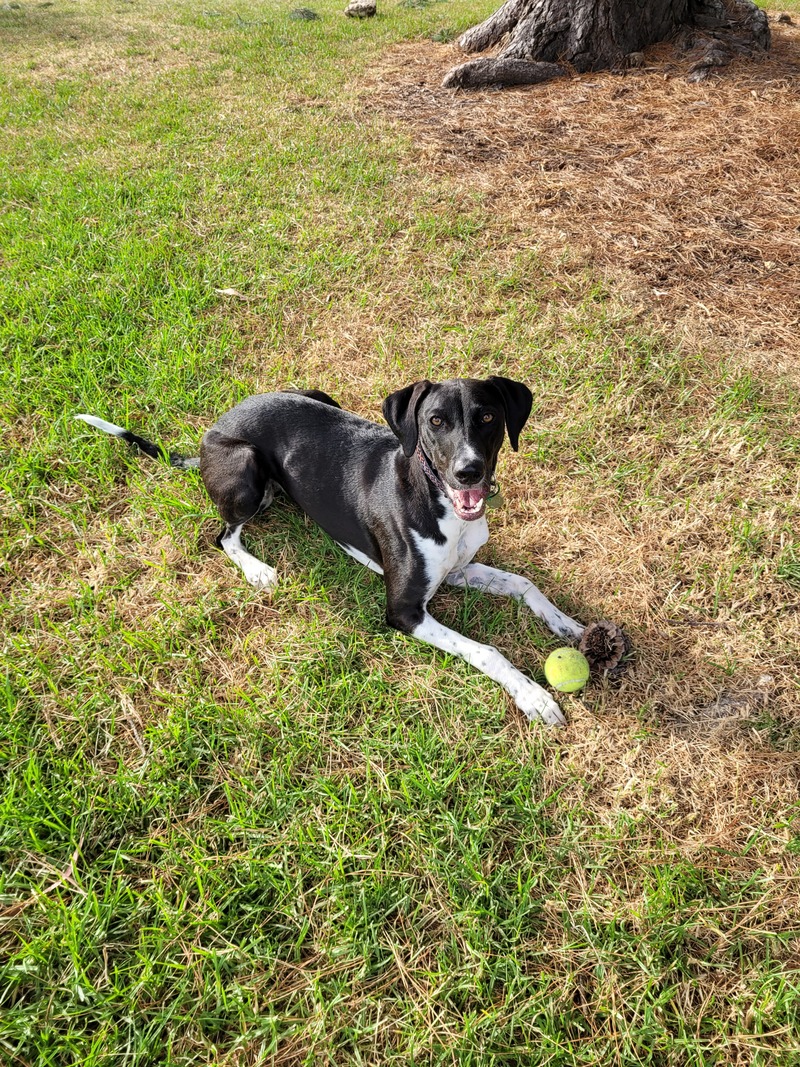Sometimes weSometimes as part of our work, we are required to conduct noise assessments at night in a variety of different locations. This can include high risk areas such as industrial areas, near railways or near bars and clubs. As part of our site risk assessments, we sometimes find it is deemed necessary to have security with us for our own safety. Hiring a security guard or having two consultants on site at any one time can be expensive for our clients. As part of our philosophy of promoting innovation in the industry, we instead brought on a new member to the ACA team. Frankie is a large cross breed of greyhound and German short hair pointer. While guard dogs are usually chosen for their size, temperament and barking at potential intruders; we needed a dog that is quiet. She is specifically trained to be quiet while we're conducting monitoring and to act as a deterrent for potential threats to our staff. Below you can see her working on site with us in a side street of an area of the city with lots of bars and clubs. One of the unforeseen benefits to bringing Frankie with us to site is that she deters the public from asking us questions and interrupting our work. People are often curious about what we are doing and approach us to talk or look at our equipment. While we are always friendly with the public, it can disrupt our measurements. If people are getting too close, Frankie will let them know to give us space through her body language. If she is given the "OK" command, she'll instantly be wagging her tail and want to be friends with anyone though.
Frankie has become a valued member of the team and is well loved by everyone. While we originally brought her on as occasional security, she has proven more valuable as an office dog, keeping us company while we work and happily finishing any lunch leftovers.
1 Comment
Acoustic Compliance Australia recently completed an environmental noise assessment for a large site in regional Victoria. As part of this assessment we got to test out using handheld LiDAR to obtain 3D models of site assets to quickly and easily use this information for noise models and auralisation projects. One of the struggles in the acoustics industry is communicating to clients what noise sources are causing issues from a visual perspective. Photos and sketches can be ok, but when a situation is complex these can sometimes not be enough. Proprietary acoustic 3D prediction software is often quite basic in how structures and noise sources are represented, with buildings usually being a grey rectangle and noise sources a dot or a coloured area or line. These simple models can usually be more than adequate if all you need to know is what the noise footprint of the site is at nearby residential receptors. However, when a client needs to show an acoustic reports to others within their organisation to actually discuss what what is causing any issues and how to fix it, this is where these models can fall down. Below is a video of the process to capture LiDAR of a the noise source and another of the scanned object turned into a 3D asset.
Once scanned, these models can be viewed at any angle and distance. Problem areas can be focussed on and pointed out allowing for easier communication. The model files can be exported in a variety of mesh and point cloud formats including DXF, LAS, STL, OBJ, FBX and many more so the 3D asset can be included in client digital systems.
These 3D models are too complex to be imported into traditional noise modelling software. However as part of Acoustic Compliance Australia's R&D, these models will serve as a detailed component in our environmental noise Auralisation service we're developing, where we will allow our clients to not only know how loud a noise is in decibels but to also be able to hear it. To find out more or for a demonstration, feel free to give us a call or email us. William Dalmau 0401 113 666 [email protected] |
New Blogs
|
Services
|
Acoustic Compliance Australia acknowledges Aboriginal and Torres Strait Islander people as the Traditional Custodians of the land and acknowledges and pays respect to their Elders, past and present
Acoustic Compliance Australia is committed to safe and inclusive work places, policies and services for people of LGBTIQ communities and their families |
Acoustic Compliance Australia © 2021
|






